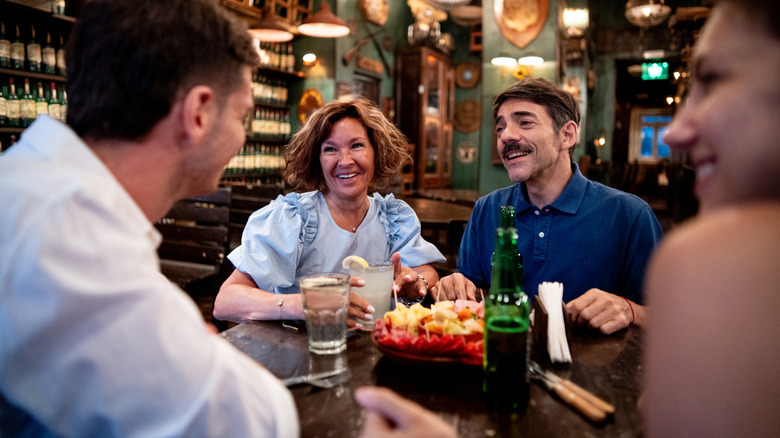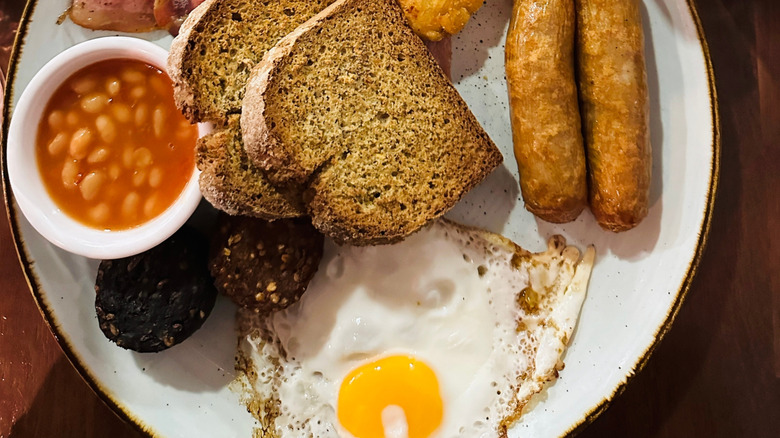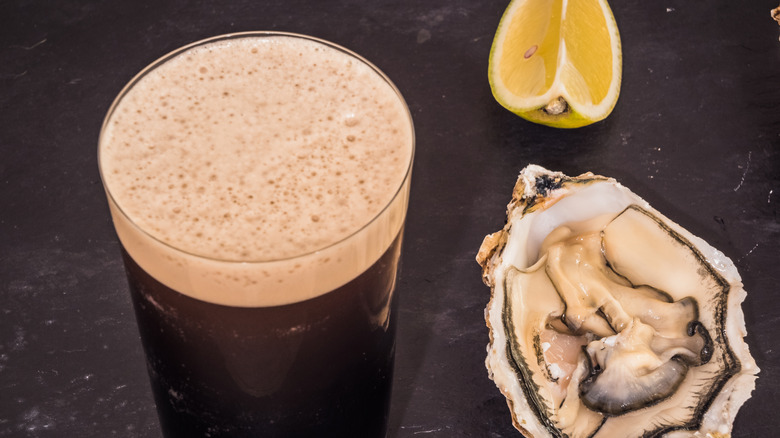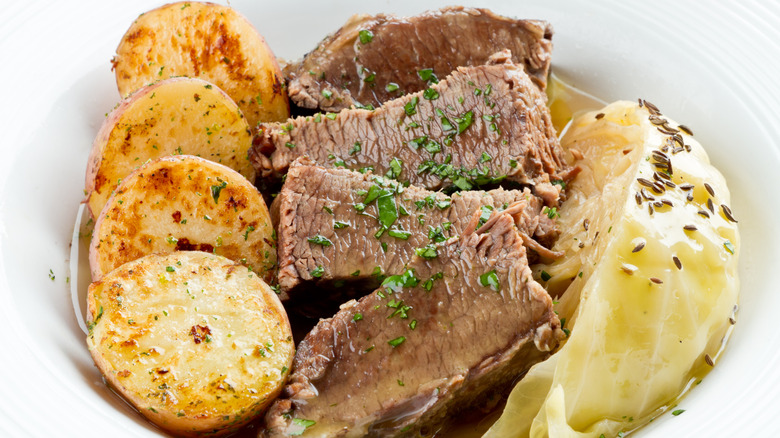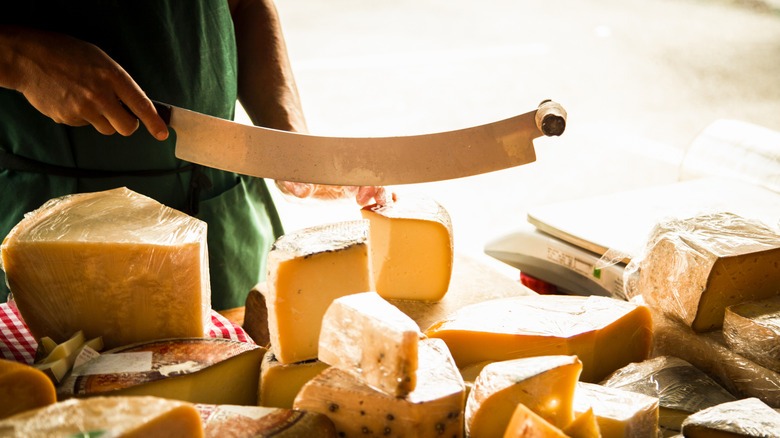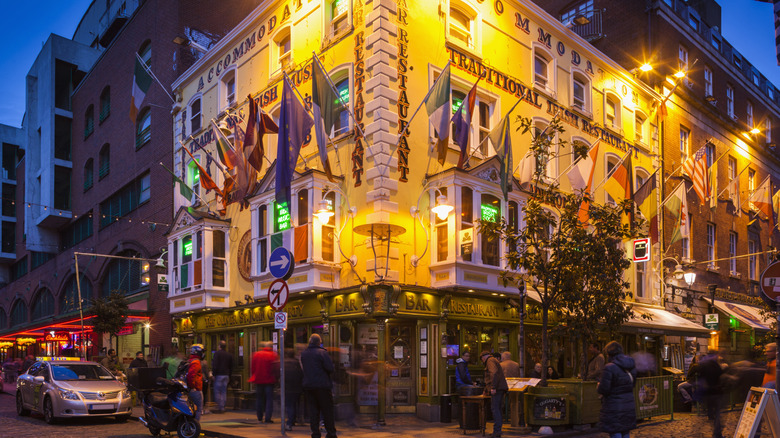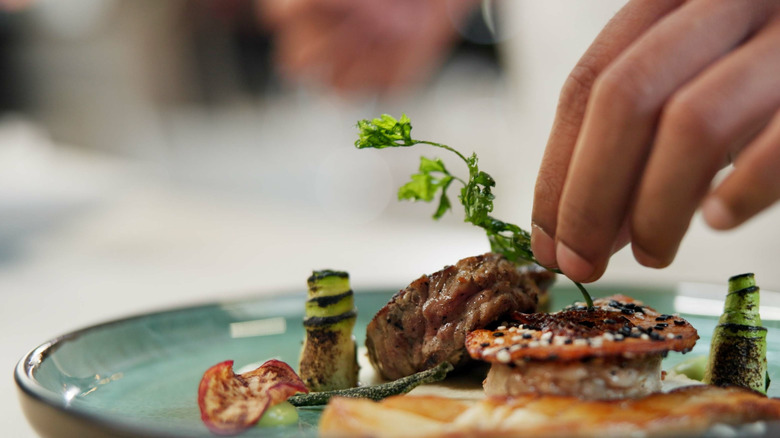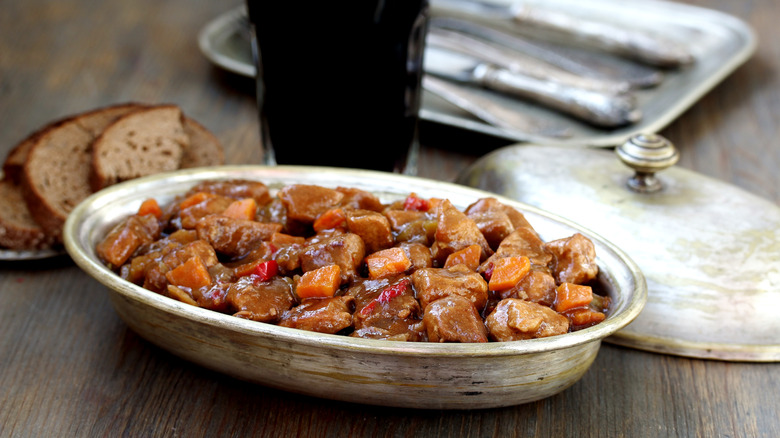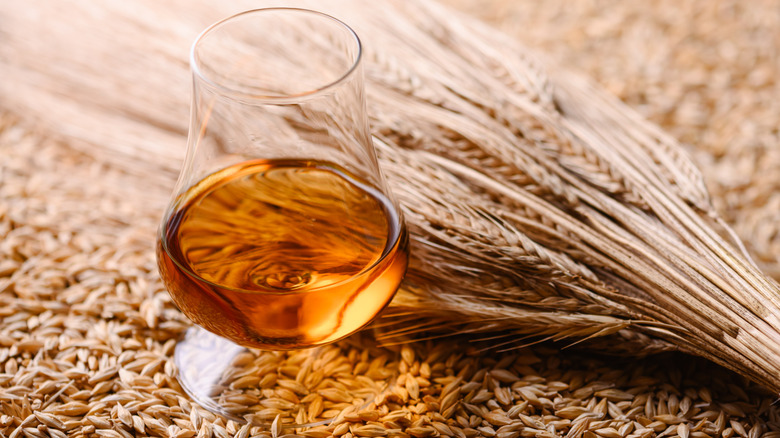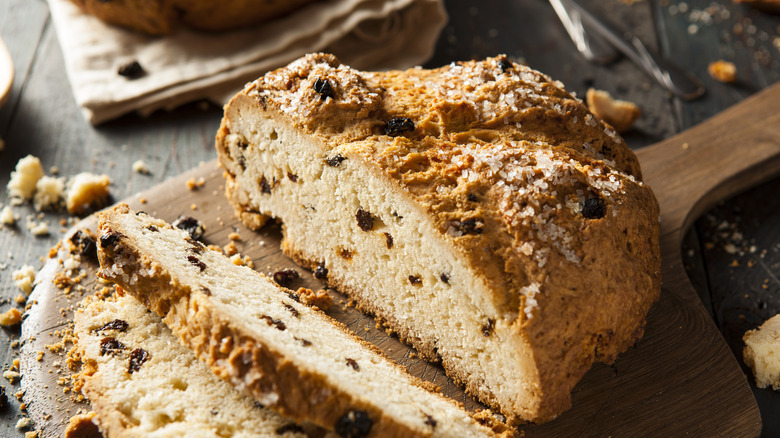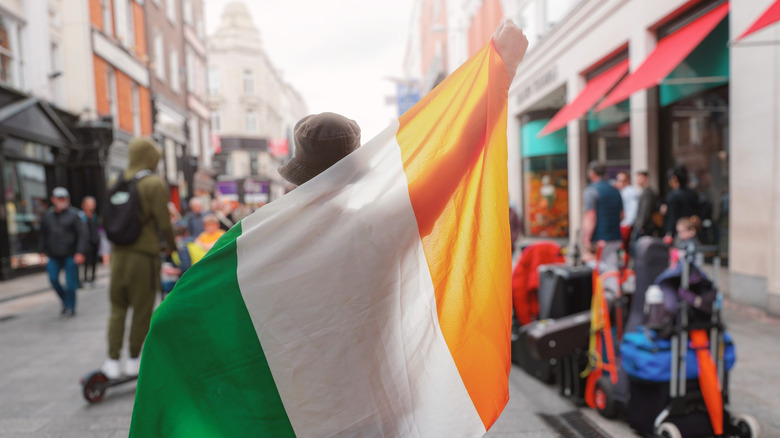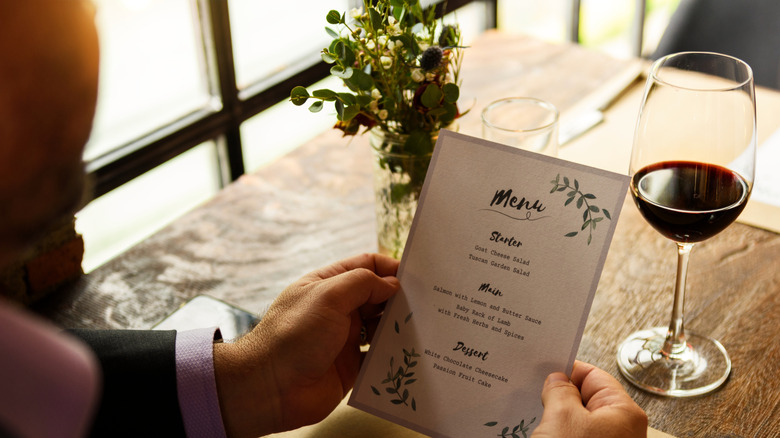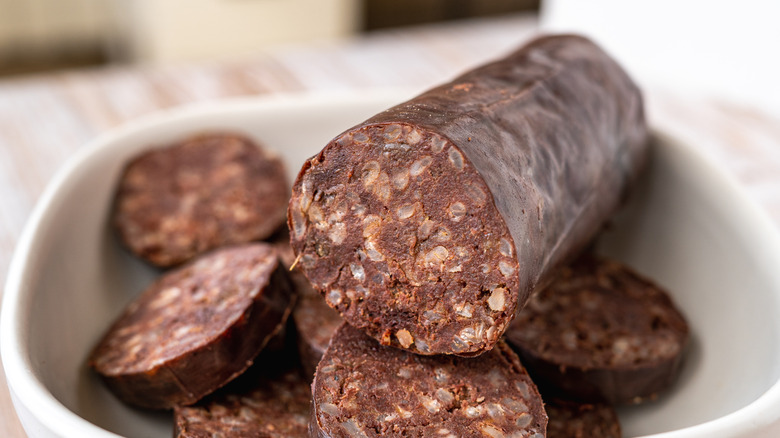Here's What To Expect Your Meals To Be Like When Visiting Ireland
What images spring to mind when you think about Ireland? Is it the astonishing coastal views from a place like Dingle, Rick Steves favorite town in all of Ireland? Is it the verdant rolling hills dotted with castles? Is it the tight quarters of the numerous pubs? Is it the stunning sunset views from Ha'penny Bridge, one of Dublin's most famous landmarks? Chances are you aren't picturing a plate of Dublin coddle because ... what even is Dublin coddle?
Unlike those of Italy and France, love of Irish cuisine has not reached a level of international admiration. In fact, it has long been considered one of Europe's lesser culinary traditions. A hugely outdated notion. The native cuisine of Ireland is one that has evolved through thousands of years of tradition. It's a diverse and flavorful array of dishes that emphasizes freshness and range from familiar favorites like Shepherds Pie, to the downright weird, like drisheen.
If you're planning a trip to the Emerald Isle and want to experience the native dishes, pay close attention. We're going to give you a taste of what you can expect your meals to be like when visiting Ireland. Regardless of diet, allergy, or preference, there is something for everyone to enjoy in this enchanting country. Let's dig in!
Enjoy a hearty breakfast in Ireland
Something you will find in almost every Irish hotel, bed and breakfast, restaurant, and pub is a full Irish breakfast. Known simply as a full Irish or a fry-up, it's among the most traditional meals in all of Ireland. This one skillet meal is designed to fill you up, and keep you that way! If you thought a plate of eggs, home fries, and diner hash was a big breakfast, wait until you see what is waiting for you in Ireland!
While the ingredients can vary from place to place, a full Irish usually consists of the following components: fried eggs, bacon rashers, black or white pudding (a type of traditional sausage), banger sausages (stop giggling), broiled tomatoes or mushrooms, fried potatoes, baked beans, potato cakes, toast, and a pot of strong black tea. Yes, that all fits on one plate and eating it all may send you into a food coma, but it'll be worth it.
Originally intended to fuel a farmers day in the fields, the breakfast has become more of a draw for tourists than native Irish citizens. Today, it is common to see a spread of full Irish ingredients at a hotel buffet, or as a complete menu item at a pub. (Personal Tip: Clontarf Castle Hotel in Dublin makes a mean Irish breakfast, and some killer scones to boot).
Sample the freshest seafood
It's sometimes easy to forget that Ireland is, in fact, an island. Roughly the size of the state of Indiana, Ireland is small enough to never be more than a few hours drive from the ocean. Also filled with rivers, lakes, and swamps, Ireland has no shortage of fish, seafood, and shellfish with which to make numerous mouth watering dishes.
Most of Ireland's 26 counties border the Atlantic Ocean, Irish Sea, or Celtic Sea. Shopping with fishmongers or dining in Irish pubs offer up a truly astonishing array. Fresh oysters are a highly common accompaniment to a pint of Guinness, and were noted as being Anthony Bourdain's hangover cure. Other shellfish include mussels, cockles, and clams, while fish like cod, kipper, haddock, monkfish, and Dublin Bay prawns. All are commonly served plain, smoked, baked into pies, or mixed into thick chowders.
The inland counties also come with abundant aquatic life. Salmon are commonly fished out of Ireland's many rivers, as are brown trout and Anguilla eels. So, no matter where you find yourself vacationing in the country, you will be able to find the absolute freshest fish/seafood. Some of the most traditional Irish fish dishes include fish cakes with tartar sauce, and the Dublin lawyer, lobster meat with whiskey and cream.
Yes, meat and potatoes are a thing
Is it stereotypical to say that Irish cuisine is heavily focused on meat and potatoes? Of course it is! It also happens to be true. While they are not the center of the culinary culture, the fact remains that potatoes and meat are key components of the Irish diet. There is a simple reason for this: potatoes have been Ireland's star crop since the 17th century. They have provided sustenance for millions over the years. As such, they are beloved staples that are put to endless creative uses.
As for the meat, beef, pork, lamb, and mutton are most likely what you are going to find on a pub or restaurant menu. Chicken is less common in Ireland, with other birds like duck, goose, partridge, and pheasants being more preferable. Rabbit and venison are also common. These can be roasted, smoked, fried, cured, or transformed into the most tremendous stews.
Some famous Irish dishes, like Shepherd's Pie, Dublin Coddle — a stew of meat, sausage, onion, and potatoes – and Champ – mashed potatoes with scallions or nettles – were created to be filling dishes made with simple, affordable ingredients. Very little in the way of spices are used in Irish cooking, allowing the quality of the ingredients to shine through organically.
Love dairy? You're in luck
If we were to boil it down to one food group the Irish take the most pride in, it would have to be dairy. Ireland boasts some of the most fertile grasslands in the world. Cultivated over thousands of years, the numerous grass species of Ireland have yielded some of the best dairy products in the entire world. The milk from cows that feed on these native grasses have created some of the greatest butter and fresh milk in the entire world.
However, more so than butter, milk, and cream, the Irish have a special fondness for cheese. There are at least 500 different types of cheese produced on the Emerald Isle. Thanks to those grasses previously mentioned, no two Irish cheeses are exactly alike. Irish farmhouse cheese is among the most unique in the world, and is made with that signature high quality milk, and allowed to develop deep and individual flavor profiles.
County Cork in the south of Ireland has long been considered the best in the country for cheese. It's produced the soft and tangy Adraham and Gubbeen cheeses, as well as the harder, saltier Coolattin Cheddar. Other famous varieties from other counties include Wicklow Blue, Killeen goats milk cheese, and flavored cheeses like Carrigaline made with Dillisk seaweed. If you love cheese, skip France. Ireland is the place to be.
Pub fare is simplicity at its finest
You cannot visit Ireland without a trip to a pub. As epicenters of culture, pubs are social hubs that provide tourists with the ultimate taste of Irish life. Pubs are so eponymous with the Irish lifestyle that the entire Beverly neighborhood of Chicago is built around several Irish pubs, proving it as an international institution. However, there is nothing like the real deal, which is why you have to enjoy a pub meal during your Irish holiday.
Though more known for the drinks they pour and the music that pours out of the booths, Irish pubs are also home to some of the freshest, most down-home Irish cooking you're likely to find. Pub fare is simplicity at its finest. Most menus change daily based on what is fresh, providing visitors with an array of different meals to choose from.
However, most pubs will also contain some of the counties most cherished staples, like fish pie, beef and Guinness stew, fish and chips, apple cake, and fresh oysters among others. Simply put, if you're looking for good wholesome food and an insight into the Irish way of life, you can't go wrong at a pub.
Fine dining is tradition with a twist
While much of Irish cuisine focuses on adherence to long-standing traditions, there's still room for the cutting edge in the Irish food scene. The Celtic Tiger, an economic boom that lasted from the 1990s to the late 2000s, allowed native Irish chefs to go abroad to France to be classically trained. Those chefs then returned to Ireland, where the country's newfound wealth created a market for their high-end haute cuisine, as well as those of international chefs seeing potential in the country.
As such, there are several Michelin-starred restaurants in Dublin, including Chapter One, Restaurant Patrick Guilbrand, Liath, and Variety Jones. All of these places put focus on the fresh ingredients offered by the island, often putting haute-cuisine twists on some of Ireland's most traditional meals.
Travelers can find fine dining adventures outside of the cities too. Connemara's Ballynahinch Castle is a luxury hotel that offers some of the greatest views in all of Ireland, but also comes with a top notch restaurant to boot. I visited this castle in 2019, and enjoyed an excellent roasted duck breast glazed with a port infusion. Quite delightful for anyone who enjoys the higher end of the culinary spectrum.
Nothing warms a rainy day like a good stew
As can be gathered by earlier entrants on this list, stew is commonplace throughout Ireland. There is hardly a menu in the country that doesn't offer at least one type of stew. Another one of those Irish meals that came about out of necessity, stew originated with the shepherds and farmers who had to make filling meals out of the ingredients they had on hand. Stew thereby served as the means by which many of Ireland's poorer citizens were able to feed themselves.
Traditionally a combination of some kind of meat, potatoes, and other root vegetables, Irish stews are thick, hearty meals that pack loads of flavor with every bite. Designed to stick to the bones, their warmth provides a perfect antidote to those rainy Irish days.
Though still a staple of farms across Ireland, stews are readily available and beloved by the larger public, especially tourists. Beef and Guinness stew is a staple of pubs. It's a thick, meaty concoction that bursts with savory richness. Other meat choices include lamb, pork, or fish if you're in one of the coastal areas. While potatoes are the main vegetable, they can sometimes be swapped out for dumplings. It all depends on where in the country you are. What's certain, however, is that any stew you order is going to taste good.
Guinness isn't the only drink on the menu
As excellent as Guinness is, and let's be real — it absolutely tastes better in Ireland – it is hardly the only drink on the menu. While there is hardly a pub in the country that doesn't have several taps dedicated to the signature stout, there are plenty more beverages to choose from if you're not one for Guinnesses mineral richness.
The other primary beer of Ireland is the red ale. Made with a combination of pale and caramel malts, the signature red hue this beer takes on makes it attractive to look at and for easy sipping. To compete with the Guinness and red ale market, a growing microbrewery economy has taken hold on the Emerald Isle. Like in the United States, creative concoctions are the name of the game at Irish microbreweries. You can locate one easily via the Independent Craft Brewers of Ireland.
Then, of course, there's whiskey. While Scotland may be home to some of the most famous whisky destinations in the world, an Irish dram is commonplace in the country, with some of them being as flavorful and well-established as some of the best single malt scotches. Offerings include the classic Jameson and Tullamore Dew, along with smaller titles like Red Breast, Writer's Tears, Yellow Spot and Teeling.
Soda bread is a complex tradition
To get personal for a moment — my immigrant Irish grandmother, who recently passed away at the age of 91, was a master at making soda bread. Hers was a sweet version, with sugar and raisins added to the traditional mix of flour and buttermilk. She shared the recipe with me as a teen, when I took an interest in learning about her heritage. She deemed me worthy of keeping the family tradition alive, making me another part of the long, complex history of Ireland's most famous bread.
Dating back several centuries, Irish soda bread is, at its most basic, a combination of flour, salt, buttermilk, and baking soda. The baking soda serves as the rising agent, as opposed to a fermented sourdough starter or active yeast. It yields a thick, hearty bread that pairs perfectly with those Irish stews.
As with other menu items in Ireland, recipes for soda bread vary from place to place. Some use whole wheat flour or oatmeal. Others add caraway seeds. Some, like my grandmother, swap out the salt for sugar. However the soda bread is made, you can rest assured that it will end up on your plate in Ireland.
Try taking a food trail
We bet you never expected there to be this much food available in Ireland, did you? We bet you're overwhelmed by all the different dishes you're going to be able to try. Listen, you don't have to fit every tasty morsel of Irish cuisine into your visit. Regardless of where in the country you end up going, you're going to find something that you like. However, if you're stuck on where to begin, it is worth considering taking part in one of Ireland's many food trails.
The Irish food trails are a regional/county specific network of eateries that take visitors on a guided, all inclusive tour of said areas, all while highlighting the local cuisine. Locations include farms, markets, restaurants, pubs, bed and breakfasts, and hotels. In each of these tours you will be able to sample some of, if not all, of the foods we've talked about so far, and likely several more.
These trails can be found across the country, and include some pretty fantastic locales. Here are a few you we recommend: The Burren Food Trail (Co. Clare), TASTE Kilkenny (Co. Kilkenny), TASTE Kerry (Co. Kerry), Sligo Food Trail (Co. Sligo), and Good Food Ireland (Co. Cork).
Dining is allergy-friendly
Though firmly rooted in centuries of tradition, Irish dining does cater to modern food preferences, especially when it comes to allergies and food sensitivities. It's no secret that, across the world, food sensitivities are at an all-time high. Restaurants have therefore been required to adjust to modern trends that cater to allergies and sensitivities by offering options that exclude certain ingredients.
While this practice is highly common in the U.S., there is concern among travelers that other countries might not be so allergy-friendly. They will not have to worry when travelling in Ireland. Most restaurants will have indicators of allergens and a list of alternative ingredients on their menu. There are also restaurants in Dublin listed on Allergy Companions that show which eateries are best to eat at for those with food allergies.
This sensitivity translates to the countryside as well. Most people in Ireland are very friendly and willing to help you out if needed. Pubs who are in the habit of changing their menus daily, won't begrudge an ingredient change or two for a paying customer. All you have to do is ask.
Expect the weird and the wonderful
Every country on earth has their own wonderfully wacky foods that couldn't come from anywhere else. But as far as Western Europe goes, Ireland has to take the cake for some of the most whimsically strange foods available for people to eat. These are the sorts of things that only come out of hundreds of years of culinary tradition. Here are a few strange sounding dishes you might encounter on an Irish menu.
Colcannon is the name for buttery mashed potatoes mixed with kale or cabbage. Blaa is a soft, pillowy potato bread roll that originated in Waterford. Boxty are potato and scallion pancakes formed by us using baking soda and buttermilk. Drisheen is a blood sausage made using cow, pig, or sheep's blood that's been mixed together with breadcrumbs, milk, salt, and bacon fat. Bram Brack is a wonderful Irish fruitcake typically made with raisins and served around Halloween.
These are just a few examples of the wonderful dishes you can expect to find on your visit to Ireland. Naturally, you'll be able to find multinational roast food chains if you really want to. But we wholeheartedly recommend going fully native and enjoying the wide range of diverse foods the Emerald Isle has to offer.
